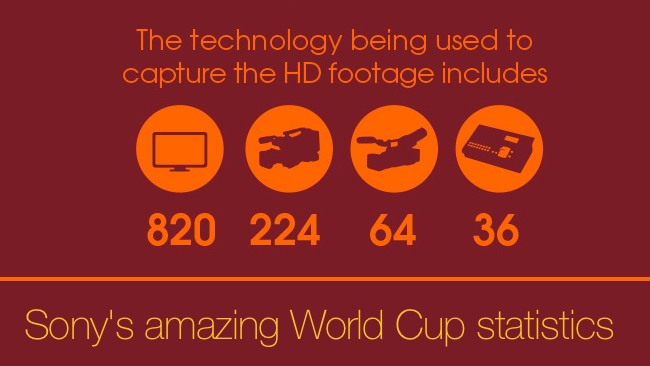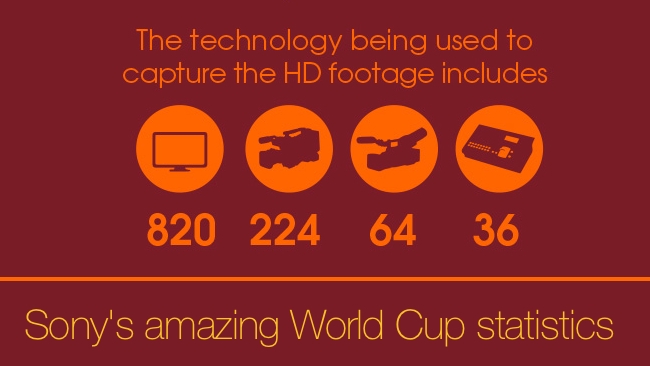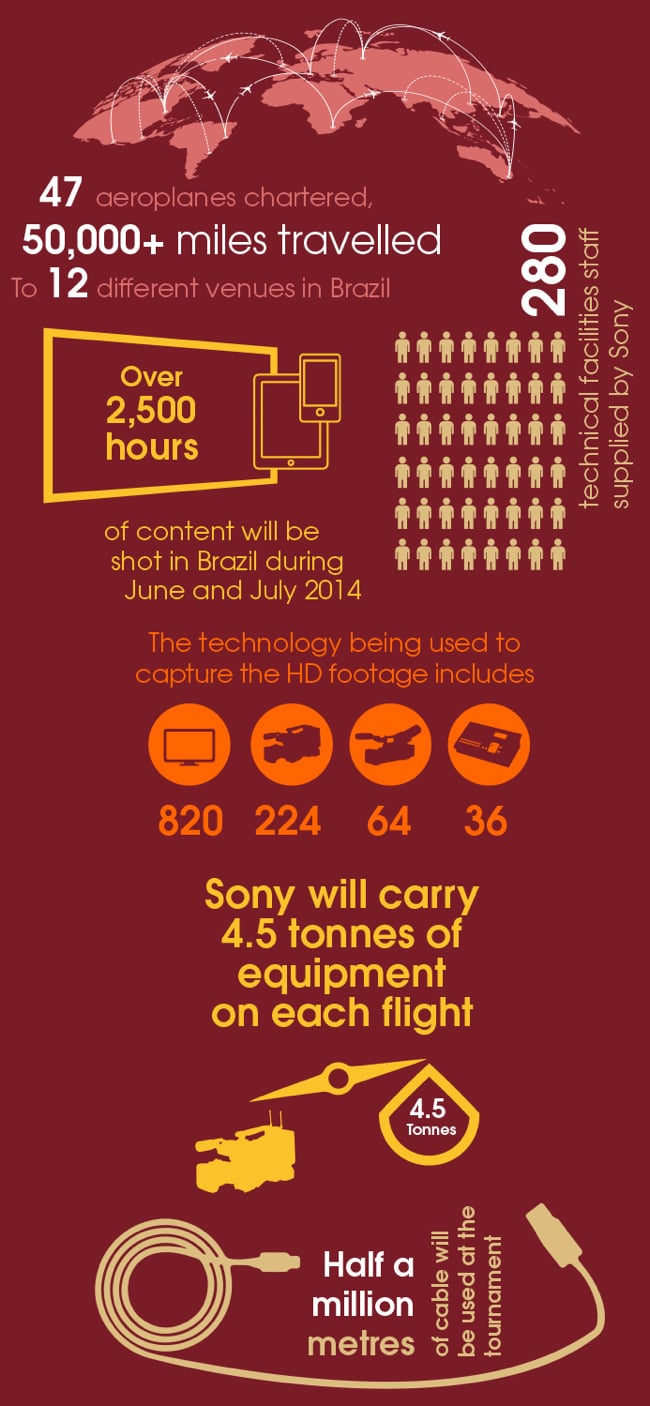
 Sony's amazing World Cup statistics
Sony's amazing World Cup statistics
When you say you're going to cover the World's biggest televised event, you have to do it in a big way. Here are the facts and figures behind Sony's coverage of the 2014 football World Cup
The football World Cup was first televised in 1954 and is now the biggest televised sporting event in the world - exceeding even the Olympic games!
Since the shadowy, smeary days of analogue black and white television, things have got a bit more complicated. We've been through SD Monochrome to SD Colour, HD, 3D (remember that?) and now - we think this will be around for a bit longer than 3D - 4K.
Exactly how complicated is shown in the infographic below. And if you want the full set of statistics, turn the page to see Sony's ultimate guide to their presence at this ultimate football festival.

Turn the page for Sony's Ultimate guide to their World Cup set-up
The wait is finally over! This summer 32 of the world’s top footballing nations will be battling it out to be crowned 2014 FIFA World Cup™ Champions. Current holders Spain and tournament hosts Brazil are among the favourites to win the coveted title, and over 64 matches, across two time zones at 12 separate venues, they will make their play for World Cup glory.
In 2010, over 20 million people (from every single country and territory) watched the FIFA World Cup™, with 3.5 billion viewers tuning into the final – 46% of the world’s population! 2014 promises to be no different as Football’s biggest showpiece proves to be the most enthralling and immersive tournament yet with over 2,500 hours’ worth of footage set to capture the hearts and minds of viewers worldwide.
As an official 2014 FIFA World Cup Brazil™ partner and HBS’s delivery partner for the tournament, Sony is dedicated to and responsible for providing every single minute of live match footage as the theatre of football unfolds. Tonnes of kit will be shipped, 47 aeroplanes chartered, 280+ HD cameras used and 280+ technical facilities staff supplied by Sony will be on hand to capture the tournament not only in high definition (HD) but in stunning 4K for the very first time. The team at Sony can’t wait to bring the coverage to your screens – whether in your lounge, pub, cinema, public fanzone or mobile device! That’s why we’ve decided to create the Ultimate Must Know Guide for the 2014 FIFA World Cup Brazil™ to share the little known facts about how the world's most widely viewed sporting event will be produced.
What you need to know: The production
The 2014 FIFA World Cup Brazil™ is the most content rich tournament to date. Over 2,500 hours of content will be shot in Brazil during June and July 2014 –over 100 days of continuous viewing. Dedicated team bench coverage, tactical player cameras and highlights feeds, dressing room footage and City guides are just some of the ways Sony will be bringing the World Cup to life.
Sony will be providing over 280 technical facilities staff, including technical and liaison teams to make broadcast history and deliver the tournament across all 12 venues.
Supplementing the permanent teams housed at each of the venues, moving teams will travel thousands of miles over the course of the tournament.
On top of the thousands of hours worth of HD footage live from Brazil, select matches will also be shot and delivered in 4K - four times the definition of HD – making 2014 the most visually detailed championship in history!
What you need to know: The lead-up
Sony has built 12 bespoke HD production containers one for each tournament venue, which will house all of the equipment needed to deliver the action live from Brazil. Each container is 40 foot - the equivalent of 3 OB trucks - and will be individually shipped on a 40 – 45 day 50,000+ mile journey to Brazil, some travelling down the Amazon for their final leg!
During March, production workshops were held in Munich to provide hands-on experience for crews ahead of the tournament
All 280+ cameras being used at the tournament will undergo exhaustive testing at Sony’s UK Technology Centre before starting their journey to Brazil – including recalibration to cope with magnetic field distortion as they cross the equator
What you need to know: On the ground
The technology being used to capture the HD footage includes 224 Sony HDC camera chains, 64 Super Slo-motion camera chains, 36 Sony switchers and 820 Sony Professional monitors. Each match will have 37 Standard Camera Plans (up from 32 in 2010), including Aerial and Cablecam, 2 Ultramotion cameras and dedicated cameras for interviews
Half a million meters of cable will used at the tournament
At the conclusion of each match, an 8.5 ton truck will deliver all moving camera equipment back to the TV compound. Teams have 90 minutes to pack down the equipment and load 51 items of cargo onto planes for an overnight trip to the next venue. 4.5 tonnes of equipment (the equivalent of 67 Lionel Messi’s) will be carried on each flight - the heaviest piece of equipment on Sony's cargo list being a 2.5 tonne cabled camera.
Each match will have two helicopters present to bring fans the best possible viewing angles.
Tags: Business


Comments